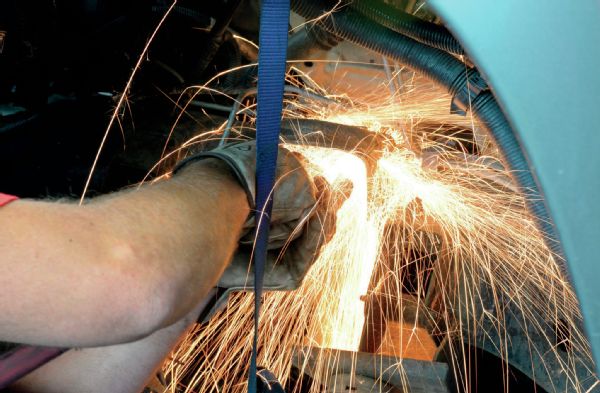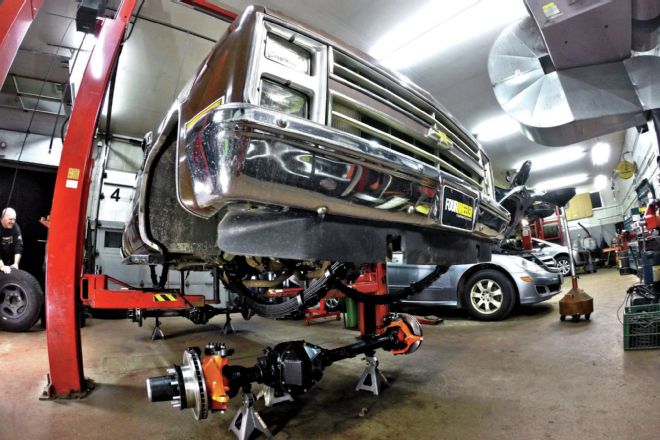
Whenever we think “leaf spring,” we can’t help but picture a crusty-old cowboy with wrinkled, leathery skin grinning out of the side of his mouth like he knows something everyone else doesn’t, while at the same time symbolically giving a one-fingered salute aimed at today’s technology. In fact, if we ever decide to get a tattoo, this guy is on the short list to get inked on the arm.
Within the scope of dated, but still very relevant automotive technology, we don’t think we’re too far out of line drawing comparisons between the leaf spring and one of John Moses Browning’s most shining achievements—the 1911 model .45-ACP semi-auto pistol. The latter was, undoubtedly, a more-challenging engineering feat, but mechanical dissimilarities aside, the current mindset on each product has clear parallels. In today’s world of long-travel, multi-link coilover suspension systems and whiz-bang, striker-fired handgun options, both the leaf springs and 1911 are viewed as antiquated technology by today’s standards. While showing their age (much like the previously mentioned grizzled-up cowboy), this doesn’t change the fact that both leaf springs and the 1911 can still be brutally effective at their respective job titles. And with a little fine-tuning, they can even be the best tools for the job. That’s commonly referred to as “standing the test of time.”
If you’ve been following along with the B.O.B. build, you’re fully aware by now that every part that gets bolted, welded, or otherwise affixed to our end-of-the-world, Bug-out Blazer needs to exhibit higher-than-normal levels of reliability, effectiveness and “field-fixable” simplicity. After all, we’re depending on B.O.B. to get us out of, in to, or around harm’s way without fail should we all find ourselves in a state of turmoil and civil unrest. Accordingly, B.O.B. is a back-to-basics type of build—one that reaches a level of reliability and bulletproof-ness that a multi-link coil-sprung, electronics-strewn, plastic-clad rig could only dream of. In the suspension world, the leaf spring is the poster child for dead-reliable, hooked-on-phonics-simple and .50-BMG-effective componentry, and that’s exactly what we’re focusing on here.
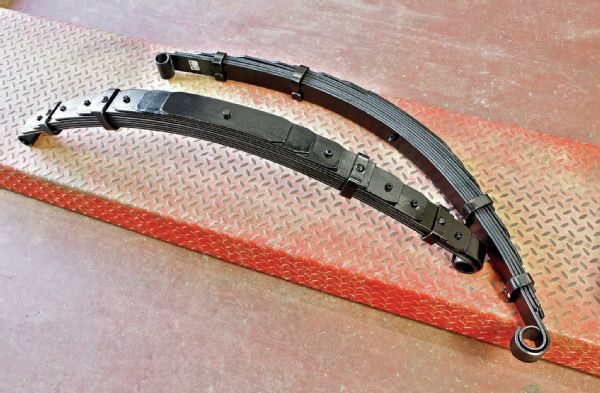 Parts that represent the highest evolution of old, but proven and effective technology, has been the theme with B.O.B all along. Case in point: the ORD Custom Leaf Springs. They’re about as close as you can get to a cutting-edge coilover, multi-link suspension technology while still maintaining the brute-force simplicity and reliability of a leaf spring. Custom built to your specs, these things are reported to provide massive amounts of wheel travel, which we’ll soon find out when B.O.B.’s rolling under its own power again.
Parts that represent the highest evolution of old, but proven and effective technology, has been the theme with B.O.B all along. Case in point: the ORD Custom Leaf Springs. They’re about as close as you can get to a cutting-edge coilover, multi-link suspension technology while still maintaining the brute-force simplicity and reliability of a leaf spring. Custom built to your specs, these things are reported to provide massive amounts of wheel travel, which we’ll soon find out when B.O.B.’s rolling under its own power again.
One of the draws to pre-’91 K5 Blazers, Suburbans, and K-series trucks for this type of build is their easily modified and swapped-out solid-axles strapped to a simplistic leaf-spring suspension system. It really doesn’t get any simpler, actually. Not only do leaf springs serve as the shock absorbing connection between axles and frame, but they also locate the axlehousings front to rear and side to side, completely negating the need for control arms and track bars. In this case, the simplicity in operation also lends itself to simplicity of modification—no need to be a wizard behind the wrench or welder to modify the suspension on a leaf-spring–equipped rig. Even a complete front wheel alignment can be done in your driveway with a tape measure and a piece of chalk after you’ve lifted it.
On a basic level, the plan with B.O.B.’s suspension was to gain enough altitude to clear the way for the 40-inch Toyo Open Country M/T’s you’ll see in the next installment and to do it without butchering the sheetmetal beyond recognition or throwing the inner fenders to the wind. A modest 6 inches of lift was the number we settled on, and using prior experience as a guide, we should be able to get away with some strategic trimming and precise bumpstop lengths to make it all work.
If you’re tackling a similar build on vintage GM iron, there’s one thing we’re pretty sure of: Offroad Design (ORD) will prove an indispensible resource for both parts and experience. Stephen Watson and the ORD crew have thrashed on their K-series rigs across some of the gnarliest trails in the country—they know what works, what breaks and the best parts to throw at your rig based on your own unique requirements. Such is the case with the Offroad Design Custom Leaf Springs we just finished strapping to the front of B.O.B. Available in lift heights from 2 to 7 inches, these springs are custom-built to your truck’s requirements to maximize wheel travel and maintain the best ride quality possible based off of the amount of weight you’ll be hanging off it. Think of them as the leaf-spring equivalent to a fully adjustable coilover shock.
Instead of using a few thick leaves like a typical lift spring, our new ORD springs use a total of 10 thinner leaves, all wearing anti-friction pads at their outer ends. Adding leaves to the pack while making them thinner is a recipe for a more-compliant compression stoke, increased articulation, and increased wheel travel. In fact, ORD claims 50 percent more wheel travel from its custom spring packs as compared to a standard lift spring— a claim we’ll be putting to the test when B.O.B. is rolling under his own power again. Along with custom lift heights, ORD can build these to custom lengths, as well as with offset center pins to fine-tune axle location within the wheel well. These rigs come from the factory with the front tires biased towards the rear of the wheel opening, so to compensate and make final tire fitment that much easier, we had ORD move our center pin locations forward by an inch. To top off the front install we matched the ORD springs with a set of 3⁄8-inch-thick ORD Heavy Duty Shackles (to replace the weak factory stamped-steel shackles and inadequate, small-diameter upper bolt) and a full complement of poly bushings and greasable spring-eye and shackle bolts all around.
Out back we took a multi-pronged approach, with BDS 4-inch lift springs, an ORD 21⁄2-inch shackle reversal kit, and ORD 1-inch Zero Rate add-a-leaves. The K5 Blazers sit low in the rear from the factory, and add to this a 40-inch spare tire and a yet-to-be-determined amount of camping, recovery, and defensive gear, the extra bit of rear lift should help level B.O.B. out when all is said and done. Running a 4-inch spring/shackle-flip combo (instead of a straight-up 6-inch-plus lift spring) will also help keep suspension action and ride quality in check.
Unlike the front, we weren’t as concerned with wheel travel as we were load-carrying capacity, but still needed a proven, well-built spring pack that we could count on to take abuse and keep on smiling (literally). Because we’ve had great luck with them in the past—as well as the fact that they come with a no-questions-asked, “No B.S. Hardcore Lifetime Warranty” (not that this will matter during the zombie apocalypse, but it’s nice to know)—the BDS “Glide-Ride” spring packs and included urethane bushings represented a solid option. These springs come with a degree shim installed to adjust for pinion angle, but since we’ll be welding new spring perches onto the 14-bolt’s tubes anyway, we’ll be able to dial in pinion angle when we burn ’em home. To replace the unneeded shim, we mated a set of ORD 1-inch Zero Rate add-a-leafs to our BDS spring packs (which get bolted in directly through the center pin) to gain a little extra lift. The Zero Rates also allow either 1 or 11⁄2-inch of front-to-rear centerpin adjustment to fine-tune axle placement in the wheelwell. Like the front, the rear axle is not perfectly centered from the factory, so we used the 1-inch adjustment hole to push the axle slightly to the rear.
The final piece of the puzzle was mounting the ORD 21⁄2-inch-lift Shackle Flip Kit in place of B.O.B.’s factory rear spring hanger/shackle arrangement. This kit does exactly what the name says, with brackets that allow you to flip the shackle from one side of the hanger to the other and essentially turn it from a tension shackle to a compression shackle, while at the same time adding a predetermined amount of lift. Also available in a 4-inch lift version, if your existing rear springs are in good shape, the Shackle Flip Kit bolts in place of the previously riveted factory hanger and represents an easy, cost-effective way to gain rear lift without using blocks. Just like the front, poly bushings and greasable spring-eye and shackle bolts were used throughout in the rear.
Temporarily sitting on a set of borrowed 32-inch rollers, B.O.B.’s new suspension makes it look a little like a dude who took one too many steroids and skipped the leg-presses altogether. B.O.B. is also rolling around with its new rear axle loosely bolted to our RuffStuff Specialties rear spring perches and no shocks, but all this will change with the next installment.
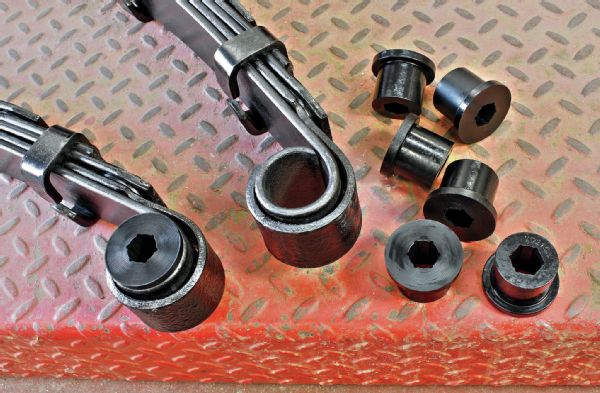
Employing a “one is none and two is one” philosophy, double military-wrap main eyes on the ORD springs represent a welcomed failsafe for B.O.B.—If one main-leaf happens to break, you still have a backup in place to keep the spring pack functioning. Spring-tip pads on all lower leafs provide friction-free movement and help facilitate bind-free suspension action. To finish our spring packs off, we paired them with greasable poly bushings for a durable and stable frame connection.
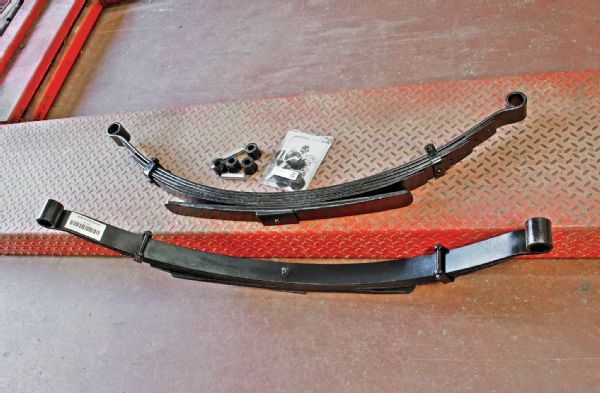
Our K5 will be playing pack mule for multiple occupants, so load-carrying capacity trumps gobs of wheel travel out back. For a solid foundation, a pair 4-inch BDS lift springs got the nod for the key ingredient in B.O.B.’s multi-pronged rear suspension plan. They come complete with poly bushings and a no-questions-asked lifetime warranty. It’s nice to know BDS won’t have a problem with damage from a nuclear blast, I.E.D. explosion, the after-effects of a super volcano, or being covered in zombie guts.
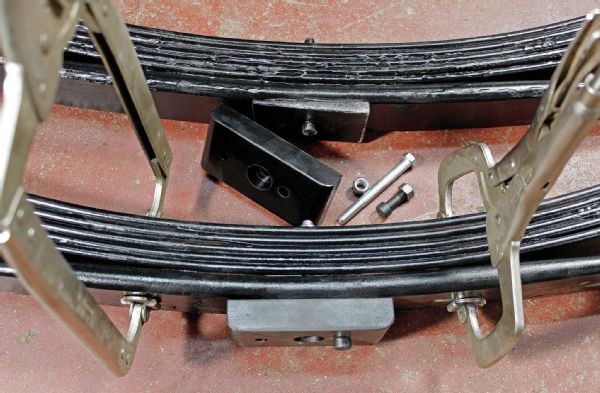
The second part of our rear suspension plan involved replacing the degree shims that came on our BDS springs with a set of ORD 1-inch Zero Rates. The Zero Rates do nothing to change spring rate (hence the “zero-rate”), and since they get bolted in through the centerpin just like an additional leaf (with the leaves clamped together to keep them from separating), they’re not blocks either. What they are, however, is awesomely convenient. We knew B.O.B. would need a little extra lift in the rear compared to the front, as well as a slight axle shift towards the rear of the wheelwell. The Zero Rates let us do both.
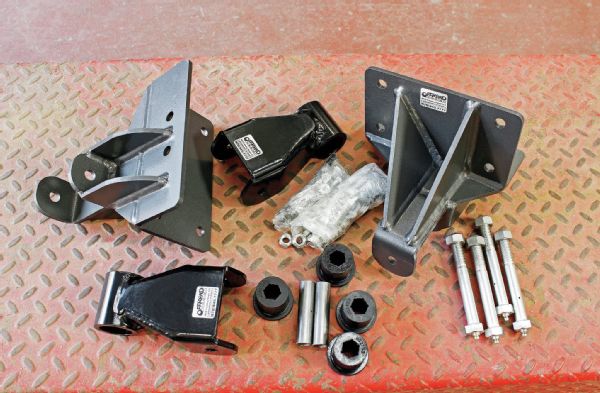
Need clearance for bigger tires but don’t want to replace perfectly good leaf springs? Want more lift without sacrificing spring rate? B.O.B. needed the latter, and the ORD Shackle Flip Kit was the perfect solution. The Shackle Flip brackets can be had in either 2 1⁄2 (shown) or 4-inch-lift flavors and replace the stock stamped rear-spring hangers with much-more-rugged 1⁄4-inch welded plate-steel brackets. We also scrapped the stamped factory shackles in favor of 4 1⁄2-inch ORD HD Super Shackles, poly bushings, and greasable bolts for a bulletproof rear-spring hinge point.
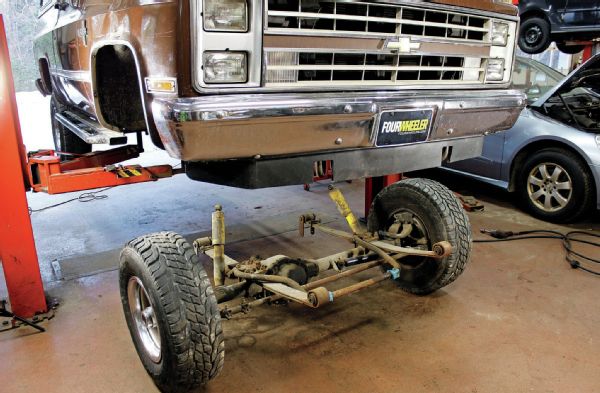
Replacing both suspension and axles in one shot has its benefits; namely, you can unbolt the entire shebang and roll it out from underneath like a wheelbarrow in lickety-split-like fashion. Since the previous owner replaced all the common wear-components both front and rear shortly before the title was signed over to us, the factory stuff was in tip-top shape and definitely worth something to somebody.
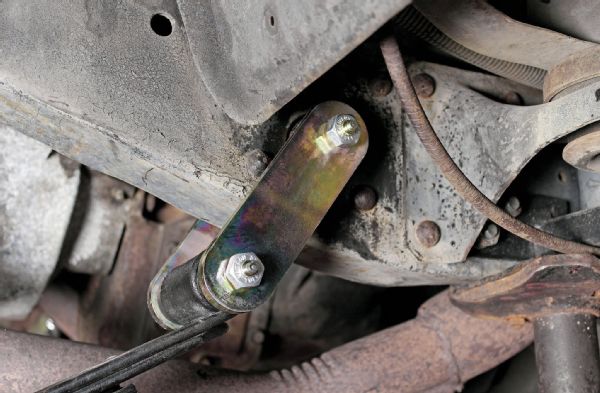
With the new front suspension hanging (which took all of about 10-minutes) here’s a look at our new ORD Heavy Duty Front Shackles we swapped in-place of the weak factory pieces. The HD shackles are a two-fold strength upgrade: you get beefier, 3⁄8-inch thick side plates, and secondly, new poly bushings that accept a larger, 1⁄2-inch-diameter greasable bolt versus the factory 7⁄16-inch bolt. For ’88-’91 K5s like B.O.B. (including Suburbans and 1-ton trucks), the HD shackles are the exact same length as your factory shackles. For pre-’88 rigs, they’re a 1⁄2-inch longer, which really doesn’t have a measurable consequence one way or the other when using stock-length springs.
PhotosView SlideshowBefore we could mount the ORD Shackle Flip brackets, we needed to liberate the factory stamped hangers from the framerails. These are held in place with six large steel rivets per side, the heads of which need to be shaved off to pop them free from the frame. We tackled this two different ways to see which tactic was more time-efficient: burn ’em off with a torch or cut a slice in the head and shear them off with an air chisel. The torch won. You could also grind them off or drill them out if those were the tools you had. Just make sure you don’t have any fuel leaks if you’re taking the torch route!
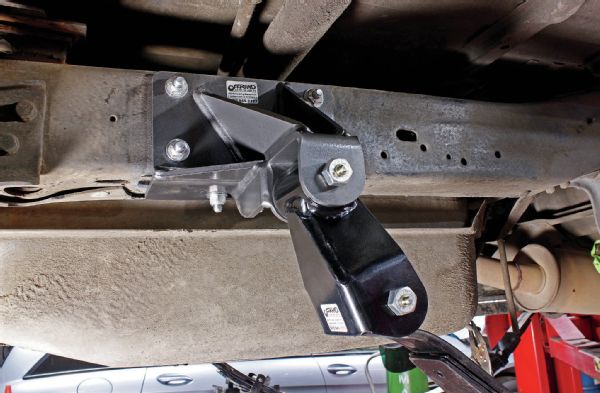
In retrospect, it would’ve been a whole lot easier just to bite the bullet and lower the fuel tank (if even just a little bit), but in the end we were able to snake the nuts around the backside of the frame and bolt our new ORD Shackle Flip Brackets in place without touching the tank. Since the shackles are now pointed down instead of up, they’re vulnerable to rock damage, but since we replaced the weak factory shackles with ORD’s 1⁄4-inch-thick steel HD Super Shackles, there’s no reason to lose sleep over it. Greasable bolts will keep the poly bushings squeak-free and ensure smooth suspension action.
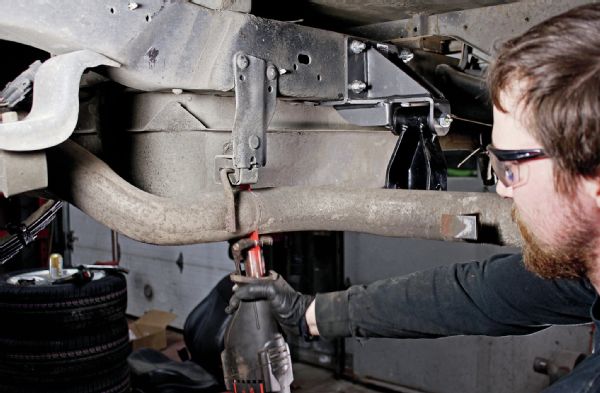
Before we could sling the driver-side rear spring into place, we needed to lop off the 90-degree elbow on the factory exhaust tailpipe to clear the spring’s path to the now-lower shackle. Conveniently, you can make the cut just downstream of the last hanger and either leave the pipe as-is or add to it and dump it out the side or back. We’re not sure where we want to do with it yet so we left enough meat to weld to down the road.
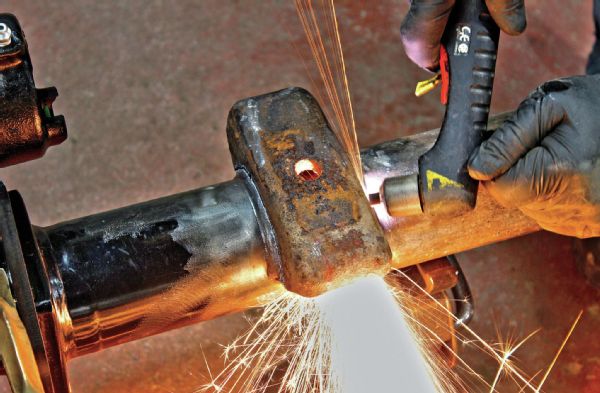
Since the spring-perch spacing is about 3-inches narrower overall on the mid-’80s GM 1-ton truck that the 14-bolt rear axle was scavenged from, we needed to buzz the original perches off with a plasma cutter before we could mate springs with axle. A grinder or torch would also get the job done but just not as quick or cleanly. Since we’re swapping out B.O.B.’s aluminum NP208 T-case for something substantially stouter (stay tuned), we won’t know where the output yoke is going to end yet or where the rear axle’s pinion needs to be pointed for proper driveline angles. For now, we’ll sandwich the RuffStuff perches between the springs and axletubes using the new U-bolts so we can roll B.O.B. around.
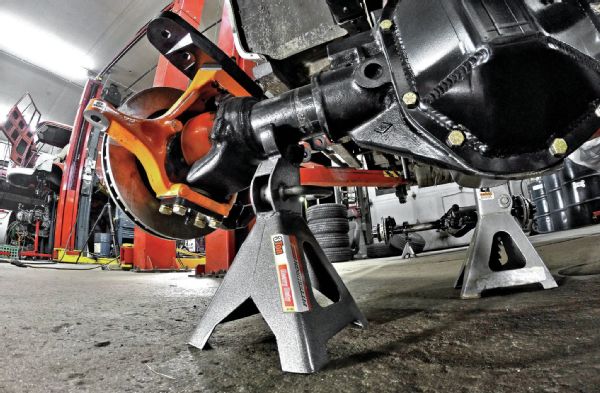
At this point we’re ready to introduce B.O.B.’s new suspension to the new axles. Having a lift was mighty convenient and let us line up both axles with the spring centerpins on a quartet of 3-ton jackstands and bolt everything in place in one shot. It’s jobs like this that make us appreciate Harbor Freight Tools for stuff like the Pittsburgh Heavy Duty jackstands seen here. It’s tough to beat the company’s cost-per-tool ratio when you need multiple versions of the same tool—especially considering that most of their stuff has held up extremely well to our abuse over the years. While we were at it, we also snagged a couple sets of the company’s tall 6-ton jackstands to reach B.O.B.’s frame when it’s done and rolling on 40s.
PhotosView Slideshowpictured pre- and post-suspension surgery, now resting on some temporary rolling stock. With replacement spring packs, add-a-leaves (both additional leaves and Zero Rates), taller shackles, shackle-flip brackets, and lift blocks all still readily available for these older rigs, there are no shortage of ways to easily (and cost-efficiently, if you’re on a budget) gain altitude and tire clearance. Each component of B.O.B.’s suspension was chosen for a purpose, and so far, our plan is coming together nicely. Fingers crossed that the apocalypse holds off ’til he’s done.


